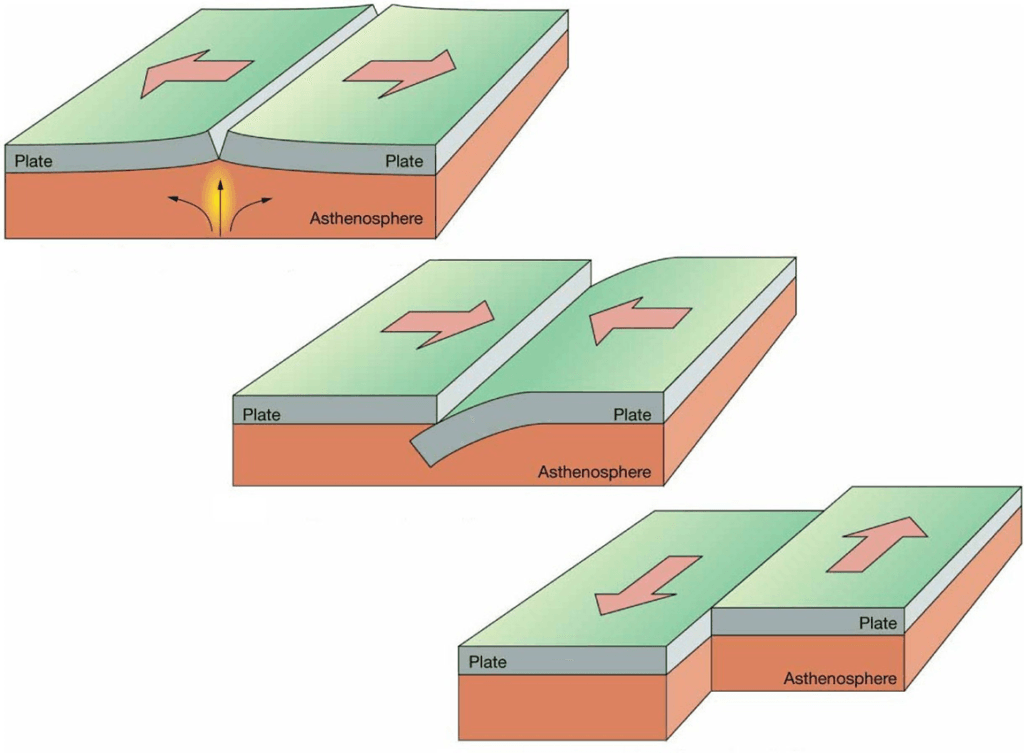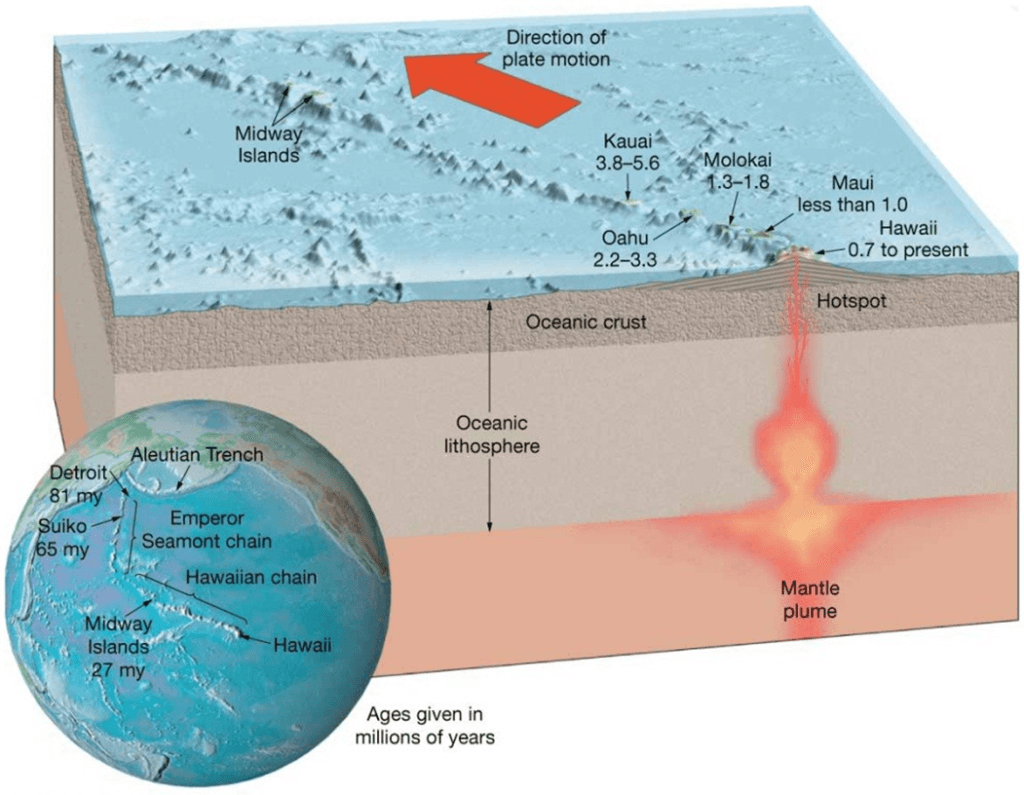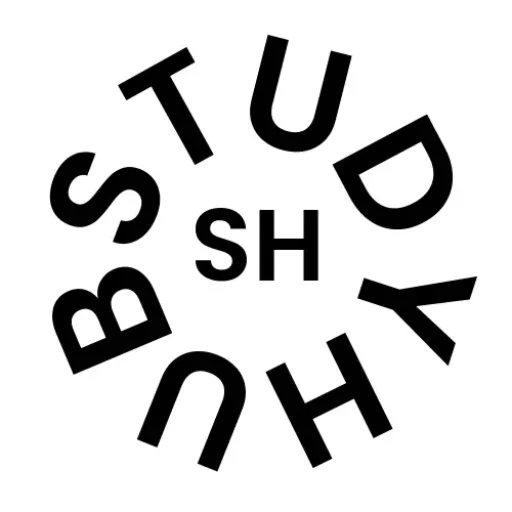Chapter Overview
- Much evidence supports plate tectonics theory.
- The plate tectonics model describes features and processes on Earth.
- Plate tectonic science has applications to Earth Science studies.
- Configuration of land and oceans has changed in the past and will continue to change into the future.
Plate Tectonics
- Alfred Wegener first proposed in 1912
- Called it “Continental Drift”

Evidence for Continental Drift
- Wegener proposed Pangaea – one large continent existed 200 million years ago
- Panthalassa – one large ocean
- Included the Tethys Sea
- Noted puzzle-like fit of modern continents
- Puzzle-like fit corroborated in 1960s
- Sir Edward Bullard used computer models to fit continents.
- Matching sequences of rocks and mountain chains
- Similar rock types, ages, and structures on different continents
- Glacial ages and other climate evidence
- Evidence of glaciation in now tropical regions
- Direction of glacial flow and rock scouring
- Plant and animal fossils indicate different climate than today.


- Distribution of organisms
- Same fossils found on continents that today are widely separated
- Modern organisms with similar ancestries

Objections to Early Continental Drift Model
- 1915 – Wegener published The Origins of Continents and Oceans
- Suggested continents plow through ocean basins
- Met with hostile criticism and open ridicule
- Tidal gravitational attractions too small to move continents
- Proposed mechanism defies laws of physics
Evidence for Plate Tectonics
- New evidence from World War II
- Sea floor studies with sonar
- New technology enabled study of Earth’s magnetic field
- Earth’s magnetic field and paleomagnetism
- Earth has magnetic polarity
- North and South polarities
- Magnetic polarity recorded in igneous rocks
- Magnetite in basalt

- Paleomagnetism –study of Earth’s ancient magnetic field
- Interprets where rocks first formed
- Magnetic dip

- Apparent polar wandering
- Location of North Pole changed over time
- Magnetic dip data

Earth’s Magnetic Pole

Magnetic Polarity Reversals
- Earth’s magnetic polarity reverses periodically
- Recorded in ancient igneous rocks
- 176 reversals in past 76 million years
- Unpredictable pattern

Paleomagnetism and the Ocean Floor
- 1955 – deep water rock mapping
- Magnetic anomalies – regular pattern of north-south magnetism “stripes”
- Stripes were symmetrical about long underwater mountain range
Sea Floor Spreading
- Harry Hess
- World War II submarine captain and geologist
- Depth recordings show sea floor features History of Ocean Basins
- Seafloor spreading
- Mantle convection cells as driving mechanism
Plate Tectonic Processes

Sea Floor Spreading
- Mid-ocean ridge – spreading center
- Subduction zones – oceanic trench site of crust destruction
- Subduction can generate deep ocean trenches.
Sea Floor Spreading Evidence
- Frederick Vine and Drummond Matthews (1963)
- Analysis of igneous rock stripes around mid-ocean ridge
- Sea floor stripes record Earth’s magnetic polarity

Age of Ocean Floor
- Late 1960s deep-sea drilling
- Radiometric dating of ocean rocks
- Symmetric pattern of age distribution about mid-ocean ridges
- Oldest ocean floor only 180 million years old

Heat Flow
- Heat flow – heat from Earth’s interior released to surface
- Very high at mid-ocean ridges
- Low at subduction zones
Earthquakes as Evidence
- Most large earthquakes occur at subduction zones.
- Earthquake activity mirrors tectonic plate boundaries.

Global Plate Boundaries

Plate Tectonics Theory
- Lithosphere – tectonic plates that float on ductile asthenosphere
- Large-scale geologic features occur at plate boundaries.
- Two major tectonic forces
- Slab pull
- Slab suction
Types of Plate Boundaries

Examples of Plate Boundaries
Characteristics, Tectonic Processes, Features, and Examples of Plate Boundaries
| Plate Boundary Type | Plate Movement | Crust Types | Sea Floor Created or Destroyed? | Tectonic Process | Sea Floor Features | Geographic Examples |
|---|---|---|---|---|---|---|
| Divergent Plate Boundaries | Apart (↔) | Oceanic-oceanic | New sea floor is created | Sea floor spreading | Mid-ocean ridge; volcanoes; young lava flows | Mid-Atlantic Ridge, East Pacific Rise |
| Continental-continental | New sea floor created as continent splits apart | Continental rifting | Rift valley; volcanoes; young lava flows | East Africa Rift Valleys, Red Sea, Gulf of California | ||
| Convergent Plate Boundaries | Together (→←) | Oceanic-continental | Old sea floor is destroyed | Subduction | Trench; volcanic arc on land | Peru–Chile Trench, Andes Mountains |
| Oceanic-oceanic | Old sea floor is destroyed | Subduction | Trench; volcanic arc as islands | Mariana Trench, Aleutian Islands | ||
| Continental-continental | N/A | Collision | Tall mountains | Himalaya Mountains, Alps | ||
| Transform Plate Boundaries | Past each other (→↔) | Oceanic | N/A | Transform faulting | Fault | Mendocino Fault, Eltanin Fault (between mid-ocean ridges) |
| Continental | N/A | Transform faulting | Fault | San Andreas Fault, Alpine Fault (New Zealand) |
Divergent Boundary Features
- Plates move apart
- Mid-ocean ridge
- Rift valley
- New ocean floor created
- Shallow focus earthquakes
- Intensity measured with seismic moment magnitude

Divergent Plate Boundary

Generation of a Divergent Boundary

Formation of a Rift Valley

Types of Spreading Centers
- Oceanic rise
- Fast-spreading
- Gentle slopes
- East Pacific
- Oceanic ridge
- Slow-spreading
- Steep slopes
- Mid-Atlantic
- Ultra-slow
- Deep rift valley
- Widely scattered volcanoes
- Arctic and southwest India

Convergent Boundary Features
- Plates move toward each other Oceanic crust destroyed
- Ocean trench
- Volcanic arc
- Deep focus earthquakes
- Great forces involved
- Mineral structure changes associated
Three Types of Convergent Boundaries

Types of Convergent Boundaries
- Oceanic-Continental Convergence
- Ocean plate is subducted
- Continental arcs generated
- Explosive andesitic volcanic eruptions

- Oceanic-Oceanic Convergence
- Denser plate is subducted
- Deep trenches generated
- Volcanic island arcs generated
- Continental-Continental Convergence
- No subduction
- Tall mountains uplifted
- Himalayas from India-Asia collision

Transform Boundary Features
- Offsets oriented perpendicular to mid-ocean ridge
- Segments of plates slide past each other
- Offsets permit mid-ocean ridge to move apart at different rates
- Shallow but strong earthquakes
- Oceanic Transform Fault – ocean floor only
- Continental Transform Fault –cuts across continent
- San Andreas Fault
- Transform faults occur between mid-ocean ridge segments.

Applications of Plate Tectonics
- Mantle Plumes and Hotspots
- Intraplate features
- Volcanic islands within a plate
- Island chains
- Record ancient plate motions
- Nematath – hotspot track

Global Hotspot Locations

Hawaiian Island – Emperor Seamount Nematath

Plate Tectonics and Intraplate Features
- Seamounts
- Rounded tops
- Tablemounts or guyots
- Flattened tops
- Subsidence of flanks of mid-ocean ridge
- Wave erosion may flatten seamount.

Coral Reef Development
- Fringing reefs –develop along margin of landmass
- Barrier reefs –separated from landmass by lagoon
- Atolls – reefs continue to grow after volcanoes are submerged

Great Barrier Reef Records Plate Movement

Detecting Plate Motion with Satellites

Paleogeography
- Paleogeography – study of ancient continents Continental accretion
- Continental material added to edges of continents through plate motion
- Pangaea – 540 million to 300 million years ago
Breakup of Pangaea
- 180 million years ago – Pangaea separated
- N. and S. America rifted from Europe and Africa
- Atlantic Ocean forms
- 120 million years ago – S. America and Africa clearly separated
- 45 million years ago – India starts Asia collision
- Australia moving north from Antarctica
Future Predictions
- Assume same direction and rate of plate motions as now
- Atlantic will enlarge, Pacific will shrink
- New sea from East Africa rift valleys
- Further Himalaya uplift
- Separation of North and South America
- Part of California in Alaska
World Map 50 million Years in Future

Wilson Cycle
- John Tuzo Wilson
- Plate tectonics model shows life cycle of ocean basins
- Formation
- Growth
- Destruction

REFFERENCE- Essentials of Oceanography by Alan P. Trujillo and Harold V. Thurman (11th edition)
Reference: All images and content are taken from Essentials of Oceanography by Alan P. Trujillo and Harold V. Thurman, 12th Edition.

